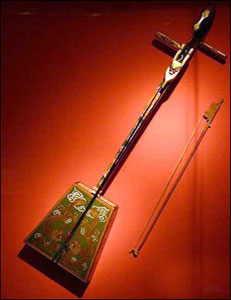| Tools: Save | Print | E-mail | Most Read |
| Mongolian Musical Instruments |
| Adjust font size: |
l Morin Khuur (string instrument - horse-head-violin)
This instrument is used to play polyphonic melodies, because with one stroke of the bow the melody and drone-strings can be played at the same time. The morin khuur is the most widespread instrument in People say that it is connected with a handsome man. It is also played when a ewe doesn't want to suckle her lamb. It is believed that the ewe, hearing this music, will feel better and accept her lamb. l Khuuchir (string instrument) Formerly, the nomads (called "the savages") mainly used the snake
The khuuchir has a small, cylindrical, square or cup-like resonator made of bamboo, wood or copper, covered with a snake skin and open at the bottom. The neck is inserted in the body of the instrument. It usually has four silk strings, of which the first and the third are accorded in unison, whereas the second and fourth are tuned in the upper fifth. The bow is coated with horsetail hair and inseparably interlaced with the string-pairs; in Chinese this is called "sihu," that is "four," also meaning, "having four ears." The smaller instruments have only two strings and are called "erh'hu," that is "two" in Chinese. l Yatga The yatga is a half-tube zither with a movable bridge. It is constructed as a box with a convex surface and an end bent towards the ground. The strings are plucked and the sound is very smooth. The instrument was considered to be sacrosanct and playing it was a rite, bound to taboos. The instrument was mainly used at court and in monasteries, since strings symbolized the twelve levels of the palace hierarchy.
Shepherds were forbidden to play the twelve-stringed zither, but they were allowed to play the ten-stringed zither, which was also used for interludes during recitations of epics. Mongolians traditionally play three types of this zither, differentiated by their resonators or hollow bodies in which the sound is amplified. Designs include the master yatga; ikh gariing yatga, the national yatga; akhun ikh yatga, and the harp, called the bosoo yatga. |
| Tools: Save | Print | E-mail | Most Read |
 |
| Related Stories |
|
Product Directory China Search |
Country Search Hot Buys |


